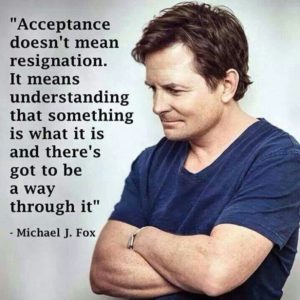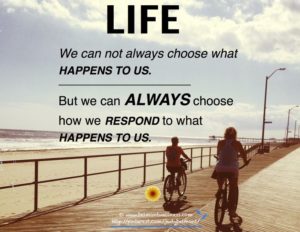“It is what it is” – Part of the recipe for acceptance?
Our response to life events has an undeniable impact on our health
I often think of acceptance about anything in life in terms of the saying, “it is what it is.” For a long time I very much disliked this statement. I thought it was a copout. I always thought another line should be added that says, “but it doesn’t have to be.”
For much of my life, I believed that nothing had to be how it was if we didn’t want it to be. When I realized there are some things we can’t do much or anything about, my attitude changed. This made a very positive impact on my ability to cope better with chronic, persistent pain from dystonia, a neurological disorder that accompanies me through life.
The only thing we can really change about most things is how we respond to them. When I think about life from this perspective, I really like the saying, “it is what it is” because “it” (life events/circumstances) can’t be anything else so “it” truly “is what it is.” “It” can’t be anything else. How we deal with “it” is what matters.
That said, I am not at all resigned to think that I can’t change things about myself or the circumstances of my life, or that you can’t either. I work on improving things all the time. I have just busted my tail really hard to better accept the challenges placed before me. This helps calm my mind so I can be proactive instead of reactive, making it easier to find ways to make the best of difficult situations.

By working to find peace of mind in the present moment, no matter what I am going through, helps me deal with the dramatic life changes that come with pain and dystonia, and better roll with the punches day in and day out. Especially the emotional aspects that further fuel the physical components (I sincerely hope you will check out my book, Diagnosis Dystonia: Navigating the Journey, to learn more about this mind/body connection, even if you don’t have dystonia).
Every night I go to bed praying that I wake up with fewer symptoms than I had the previous day. If this does not happen, I am better at not fighting what I can’t change physically about myself in the moment. I can only change how I respond to how I feel and be grateful for what I am able to do on that given day. This eases my emotional tension which reduces the physical tension I feel, a common symptom of dystonia.

What helps me most are the words I use. When I say something like, “if only I didn’t have dystonia I could run/jog again,” I am punishing myself with harsh judgment. Instead I say, “I miss running/jogging, but I am so happy I can go for a walk today.” Reframing my thoughts helps me embrace the things I am able to do with more excitement and joy, and grieve less over abilities that may have been lost.
The adjectives we choose create emotions such as joy, excitement, peace, contentment, and love, or on the other side of the pendulum, stressful emotions of anger, bitterness, guilt, resentment, and hatred. All of these emotions can (and in my opinion, they absolutely do) impact our physical health in a positive or negative way. With this in mind, we must be very careful about the words we choose because of their relationship to how they make us feel and thus, the quality of our lives.

For me, this is the nuts and bolts… when we judge anything (good or bad) we define it (‘this stupid pain’, ‘that damn surgery’, ‘I hate that I can’t run anymore! Stupid neck pain!’, ‘my rotten doctor’, etc.). When we define something, we give it life because of the emotion attached to the word before the “thing.” That thing then begins to define us, which can either lift us up or tear us down.
We have to understand that everything simply is exactly how it is and leave it at that. If we label something good or bad, the life we give it stirs up the chemical factory in the brain that can be to our benefit or detriment. The words we use create emotions that turn up stress chemicals like cortisol, or “feel good” chemicals like serotonin, dopamine, and endorphin (click here to see my blog about the power of the mind). The choice is ours.
In order to find joy, we can’t dwell on what once was… just on what is. Yesterday is over and none of us are promised anything beyond this very moment in life. We don’t have tomorrow until tomorrow arrives. All we have is the present moment so this is where our focus must be. When we focus on right now and the abilities we have right now, acceptance follows, giving us greater peace of mind. This helps us better learn to be okay with what we may view as not okay, and we can stop running or fighting all the time, which is utterly exhausting.
_________________________________

Tom Seaman is a Certified Professional Life Coach in the area of health and wellness, and the author of 2 books: Diagnosis Dystonia: Navigating the Journey (2015) and Beyond Pain and Suffering: Adapting to Adversity and Life Challenges (2021). He is also a motivational speaker, chronic pain and dystonia awareness advocate, health blogger, volunteer for the Dystonia Medical Research Foundation (DMRF) as a support group leader, and is a member and writer for Chronic Illness Bloggers Network, The Mighty, and Patient Worthy. To learn more about Tom, get a copy of his books (also on Amazon), or schedule a free life coaching consult, visit www.tomseamancoaching.com. Follow him on Twitter @Dystoniabook1 and Instagram.


























Thank you, again, Tom. I love reading your encouraging thoughts. I am doing better with my Dystonia these days, but, your words help me accept other things that have happened, especially over that last year. There are more disappointments that come along in life than Dystonia. These are things that are as they are, too.
Thanks again.
Hi Barbara. I appreciate what you said very much and am so glad to hear that things have been better with your dystonia. I very much agree that there are definietely things outside of dystonia that challenge us as much, if not more. It’s hard to not try and control them even when they may be out of our control. Letting go and letting them be as they are can be so hard.